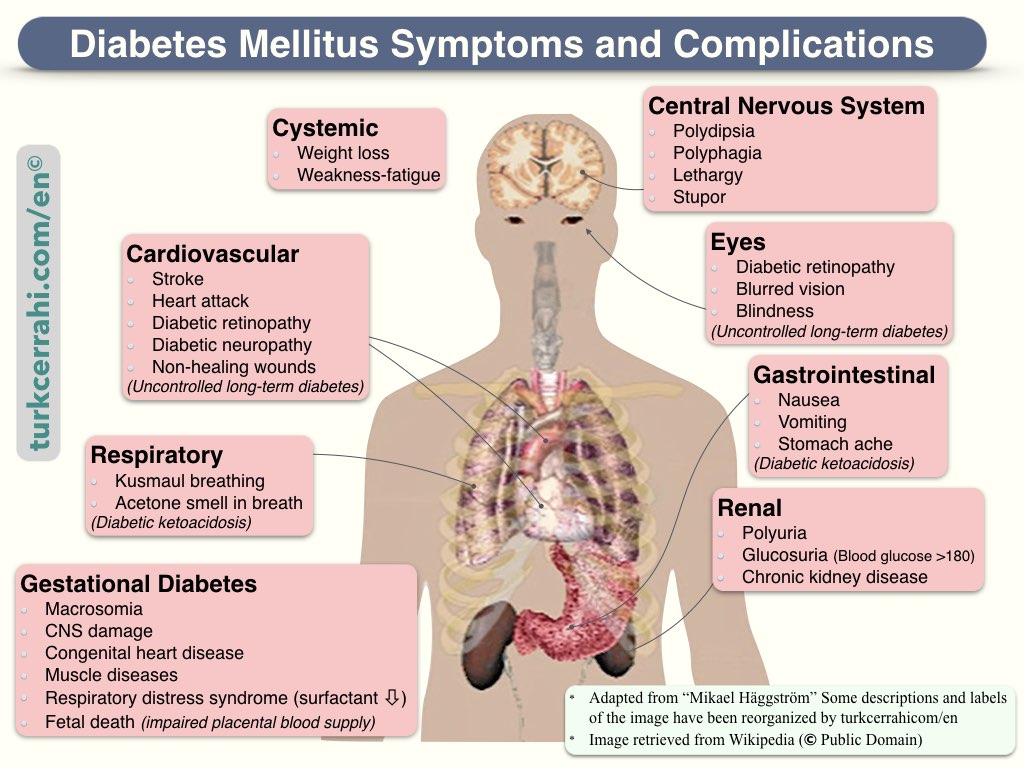Diabetes
Diabetes, when used alone, refers to the disease commonly known as “diabetes mellitus”. The ancient Greeks used the word “diabetes” for diseases that cause excessive urination (polyuria).

Image retrieved from Wikipedia on 3 July 2023. Mikael Häggström the copyright holder of this work, release this work into the public domain. Image’s Page. Some of the image’s descriptions and labels have been reorganized by turkcerrahi.com/en.
Diabetes Mellitus
It is an increase in blood sugar (glucose) levels. Diabetes mellitus occurs either because the body does not produce enough insulin (a hormone that regulates blood sugar levels) or because the body’s cells do not respond effectively to insulin. There are several types of diabetes mellitus, including type 1 diabetes, type 2 diabetes, and gestational diabetes. The typical symptoms of diabetes mellitus are the “three polys”
- Polyuria (frequent urination),
- Polydipsia (excessive thirst), and
- Polyphagia (excessive hunger).
An increase in blood glucose and osmolarity above a certain level (180 mg/dl) causes osmotic diuresis. Water loss leads to excessive urination and intense thirst (dehydration). The reason for increased appetite (polyphagia) is not clearly understood. It is probably due to the cells’ inability to meet their energy needs despite the patient’s excessive carbohydrate intake due to insulin deficiency or resistance (insulin facilitates glucose entry into cells).
Types of Diabetes
Type I diabetes occurs when the pancreas cannot produce enough insulin (insulin deficiency). Type I diabetes is also called juvenile diabetes (onset at a young age), and it accounts for 5-10% of all diabetes cases.
Type II diabetes; the tissues are insensitive to insulin (insulin resistance), and the pancreas increases insulin secretion, but it is still not enough. Type II diabetes typically occurs in adulthood (average age 45) and especially in obese individuals, accounting for 90-95% of all diabetes cases. Diabetes most commonly causes kidney and cardiovascular diseases.
Maturity Onset Diabetes (MODY) is a type 2 diabetes that starts in late adolescence and early adulthood. It is autosomal dominant.
Gestational diabetes is diabetes that occurs during pregnancy, usually in the second or third trimester. Although it often disappears after the baby is born, many of these women develop permanent diabetes later in life. Although diabetes is generally mild, early detection and treatment are necessary to prevent fetal and neonatal morbidity and mortality.
Brittle (labile-unstable) diabetes is a severe form of diabetes. Also known as “unstable diabetes,” this condition causes unpredictable fluctuations in blood sugar (glucose) levels. It is a difficult-to-control form of diabetes characterized by unpredictable swings between hypoglycemia and diabetic ketoacidosis. Although this term is used, neither the World Health Organization nor the American Diabetes Association use it as a classification. These sudden swings in blood sugar levels can lead to hospitalization.
Bronze Diabetes (hemochromatosis) is an inherited blood disorder that causes the body to store an excessive amount of iron. This iron overload can have severe health effects, most notably liver cirrhosis. Hemochromatosis is sometimes called “bronze diabetes” because it can cause darkening of the skin color along with hyperglycemia.
Central diabetes insipidus is a disease caused by insufficient production or release of antidiuretic hormone (ADH or vasopressin) as a result of neurohypophyseal damage. When ADH is insufficient, tubular reabsorption in the kidneys is insufficient as well (water cannot be reabsorbed), causing polyuria and polydipsia.
« Return to Dictionary